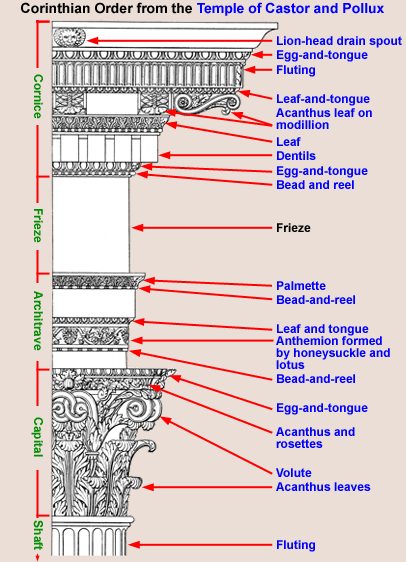Classical Motifs
OVERVIEW
Definition
Motifs are recurring decorative designs. They vary from culture to culture.
Running Patterns
Although many motifs are used singly, they are most commonly repeated or alternated with other motifs to form "running" patterns. Interlinking forms are often used to make the pattern seamless.
Transmission of Classical Motifs
The motifs developed in Greek architecture were passed on to the Romans in ancient times and brought back into use in periods of classical revival like the Renaissance.
Roman Inclination to Use Ornament
As time went on, the Roman taste for ornament increased, and many parts of buildings that had previously been left plain were covered by ornate carving.
PLACEMENT OF MOTIFS
Trims
Linear patterns were commonly used in relief on moldings, which formed features like cornices and trims around openings.
Other Architectural Features
Carved motifs also ornamented features like capitals, modillions, and friezes.
Floors
Repeating patterns were often used for the borders of Roman floor mosaics.
INDIVIDUAL MOTIFS
Dentils
A dentil is a block-shaped projection that is used in a series to support one of the moldings of a cornice. The name "dentil" reflects the resemblance of these small blocks to teeth.
Greek Key
The Greek key is a running pattern in which one or more lines progress along horizontal and vertical courses by making a series of right-angle turns. This pattern is also called a "meander" or "fret."
When used in mosaic form, this pattern could be given a three-dimensional appearance by the use of linear perspective and shading.
Guilloche
The guilloche pattern is formed by two or more bands twisting around each other in circular courses to form patterns that sometimes contain floral decorations. Tightly twisted bands form a rope-like twist, loosely twisted ones form circular or oval compartments, and multiple strands form an elaborate plait.
Vitruvian Scroll
The Vitruvian scroll is a running pattern made up of a series of scrolls that are linked into a wave-like pattern, giving rise to its being called the wave pattern. It is also called the "running-dog" pattern.
An unusual feature of this pattern is that the background above the waves is an up-side-down version of waves.
Laurel or Bay Leaves
Laurel or bay leaves are thin and pointed at the ends. They are typically used in staggered rows forming garlands suitable for half-round moldings, but they are also used in single strands.
Acanthus Leaves
The conventionalized form of the acanthus leaf is broad and fringed with small lobes along the edges.
Acanthus leaves are an essential component of the capitals of the Corinthian and composite orders. They ornament forms such as modillions and moldings. Acanthus foliage is frequently used to form other motifs like rosettes or arabesques.
Rosettes
Rosettes are stylized flowers consisting of a center surrounded by petals. They were used both singly and in repetition for moldings.
Bucrania
A bucrane or bucranium is the skull or head of an ox. Bucrania were commonly depicted as supports for festoons or garlands. The resulting scallop pattern has often been used to ornament friezes.
This motif evolved from the early practice of hanging garlands of agricultural produce and ox heads on altars on which the animals were sacrificed to the gods.
Honeysuckle and Lotus Blossoms
Honeysuckle and lotus blossoms are made up of fan-shaped clusters of petals or leaves springing from a single stem. The honeysuckle motif is also called a palmette.
When repeated or combined, they form an anthemion pattern.
COMBINATIONS OF MOTIFS
Anthemion Pattern
The anthemion (pl. anthemia) is a pattern made up of a repetition of honeysuckle blossoms, lotus blossoms, or a combination of both.
Other leaf forms, especially scrolling devices representing conventionalized vines, are often included.
Festoon Motif
The festoon motif consists of garlands of leaves, fruits, or flowers that were generally tied with ribbons and cascaded between devices like bucrania, figures, or tripod bases.
Arabesques
Arabesque ornamentation is composed of plant forms like acanthus leaves and rosettes that are integrated with scrolling, vine-like forms. The discovery in the Renaissance of the ancient Roman palace, the Domus Aurea, which included arabesques in combination with other forms, inspired many Renaissance artists and architects to incorporate similar forms in decorating walls and ceilings.
Eggs, Leaves, Darts, and Tongues
Wide motifs such as eggs and leaves were often separated by vertical motifs like darts or tongues, thin pointed projections.
The egg-and-dart pattern, whose images symbolize life and death, was a particularly popular combination for ancient moldings on cornices and capitals of Ionic order.
The individual motifs forming leaf patterns and leaf-and-tongue patterns were often separated by curving devices.
Bead-and-Reel Pattern
The bead-and-reel pattern, which was used for moldings that are round in section, consists of an alternation of two shapes: round or oval beads and grooved cylinders.
Trophies
The trophy motif, which celebrates victory, consists of a sculpted grouping of weapons, armor, and sometimes, festoons.
Trophies evolved from the Greek practice of suspending an assemblage of arms captured from the enemy from a post or cross or stacking arms on piles of stones.



 Add Placemark
Add Placemark Go Back
Go Back 





